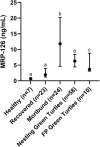Evaluation of myeloid-related protein 126, cardiac troponin C and serum amyloid A as potential plasma biomarkers of health and disease in sea turtles
- PMID: 40823445
- PMCID: PMC12350207
- DOI: 10.1093/conphys/coaf061
Evaluation of myeloid-related protein 126, cardiac troponin C and serum amyloid A as potential plasma biomarkers of health and disease in sea turtles
Abstract
Sea turtle health assessments can be strengthened by developing conserved biomarkers that discriminate between healthy and diseased states. Serum amyloid A, myeloid-related protein 126 and cardiac troponin C (CTNC) were explored as potential biomarkers of sea turtle health. Plasma concentrations initially quantified using a targeted SPARCL™ assay significantly differed between moribund (n = 15) and recovered (n = 5) loggerhead turtles (Caretta caretta). There was a negative correlation between myeloid-related protein 126 and packed cell volume (r = -0.612, P = 0.005) and total solids (r = -0.497, P = 0.03) and between and Fulton's body condition index (r = -0.684, P = 0.001). Serum amyloid A showed a relatively high interquartile range (IQR) in moribund turtles and no significant correlations with clinical parameters. Myeloid-related protein 126 and cardiac troponin C were further evaluated by an enzyme-linked immunosorbent assay in a larger dataset of loggerhead, Kemp's ridley (Lepidochelys kempii) and green (Chelonia mydas) turtles. Plasma myeloid-related protein 126 was significantly lower in captive healthy (n = 7) and recovered (n = 23) turtles than in moribund (n = 25) and nesting green (n = 58) turtles. Green turtles with fibropapillomatosis (n = 10) were not significantly different from any group. Discriminating values between healthy/recovered and moribund turtles were 1.89 and 1.97 ng/ml by receiver operating characteristic and logistic regression analyses, respectively. Myeloid-related protein 126 decreased in successfully rehabilitated turtles (n = 18 turtles; n = 67 blood samples) and was negatively correlated with body condition score (r = -0.672, P < 0.001) and packed cell volume (r = -0.443, P = 0.009). Cardiac troponin C was significantly higher (P = 0.049) in moribund turtles (n = 16) compared to healthy/recovered turtles (n = 7) and in moribund samples (n = 11) compared to recovered samples (n = 11) in serially sampled turtles (P = 0.015), but was not predictive of health status. Myeloid-related protein 126 represents a strong biomarker candidate in sea turtles. Cardiac troponin C warrants further evaluation in a larger dataset and serum amyloid A requires examination of variables affecting pathophysiologic responses in sea turtles.
Keywords: Biomarkers; MRP-126; cardiac troponin C; health; plasma; sea turtles; serum amyloid A.
© The Author(s) 2025. Published by Oxford University Press and the Society for Experimental Biology.
Conflict of interest statement
The authors have no conflicts of interest to declare.
Figures





References
-
- Ahmadireskety A, Aristizabal-Henao J, Marqueño A, Perrault J, Stacy N, Manire C, Bowden J (2020) Nontargeted lipidomics in nesting females of three sea turtle species in Florida by ultra-high-pressure liquid chromatography-high-resolution tandem mass spectrometry (UHPLC-HRMS/MS) reveals distinct species-specific lipid signatures. Mar Biol 167: 131. 10.1007/s00227-020-03747-1. - DOI
-
- Bentley BP, Carrasco-Valenzuela T, Ramos EKS, Pawar H, Arantes LS, Alexander A, Banerjee SM, Masterson P, Kuhlwilm M, Pippel M et al. (2023) Divergent sensory and immune gene evolution in sea turtles with contrasting demographic and life histories. Proc Natl Acad Sci U S A 120: e2201076120. 10.1073/pnas.2201076120. - DOI - PMC - PubMed
LinkOut - more resources
Full Text Sources

